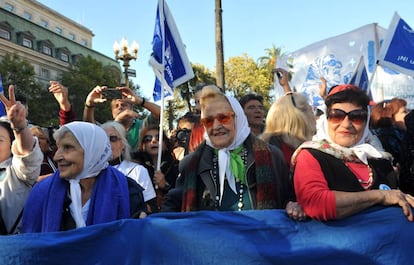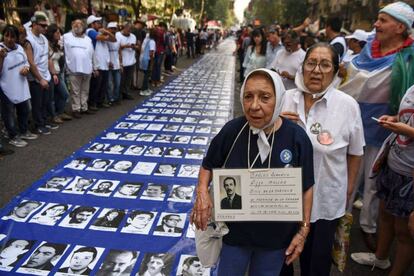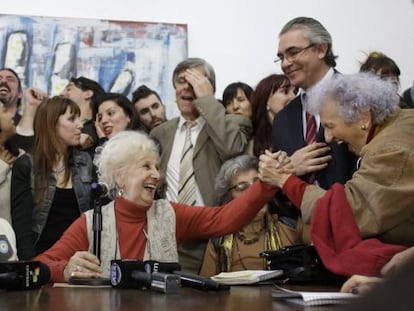Forty years later, Argentina’s bravest mothers keep marching
In 1977 a handful of women joined forces to look for their children, abducted by the military dictatorship

Forty years ago, 14 women gathered in a Buenos Aires square known as Plaza de Mayo. They were looking for their children, who had disappeared at the hands of the military dictatorship. They were scared, but their desire to find their loved ones was stronger than their fear. They spontaneously decided to join forces in order to force the military junta to give them some answers.

None of them could have imagined at the time that they were planting the seeds of a movement that would never be eradicated from the square, and which would grow to be known the world over.
These days, the capital of Argentina is organizing music festivals, photography exhibitions, symposiums and documentary screenings as a tribute to the Mothers of Plaza de Mayo, those brave souls who became a symbol of resistance against the horrors of the regime.
At first, they would sit on the benches and talk, using their knitting as a cover to throw off the uniformed guards who stared at them suspiciously. Any gathering of three or more people was forbidden under the state of siege, and at one point a police officer told them to keep moving. The women got up and began circling the monument to Belgrano and then the Pirámide de Mayo, across from the government palace known as Casa Rosada.
Having fought for life when death has passed by your side gives you courage
Hebe de Bonafini, president
“When he told us to keep moving, he triggered an endless dance,” says Nora Cortiñas, whose son Carlos Gustavo Cortiñas was kidnapped, never to be seen again, 15 days before the creation of Mothers of Plaza de Mayo.
Just like him, men and women who were members of guerrilla groups, political organizations and unions were being dragged out of their homes and plucked from the streets and taken to clandestine detention centers. Because no charges were ever brought against them, nor their location disclosed, the people who were “sucked up” in this way became los desaparecidos, or the disappeared.
The list of crimes perpetrated by the state included kidnappings, torture, baby theft from women who gave birth while in prison, and forced disappearances that took many forms, including the “death flights” in which detainees were drugged and weighed down before being thrown off aircraft and into the River. Plate.
“At first we had high hopes of finding them alive,” explains Hebe de Bonafini, president of Madres de Plaza de Mayo. “We were certain that we would find them, and that is why we put all our energy and love into that effort.”

“We couldn’t imagine that it was going to be so brutal,” adds Mirta Baravalle, whose daughter Ana María was kidnapped in 1976, when she was five months pregnant.
The state repression had begun in 1974, but it surged after the military coup of March 24, 1976. In just a few months, the desaparecidos could be counted by the thousands. At police precints and prisons, women ran into other women looking just as downcast as themselves, and asked: “You too?”
“There were 14 mothers at first; when I joined we were already 20, and the number grew by the week,” recalls Cortiñas. A few months later they began wearing white headscarves – originally these were their children’s cloth nappies – and the head covering quickly became the symbol of their struggle.
The regime wrote them off as “those crazy women,” but they didn’t care. Week after week they marched around the central monument on Plaza de Mayo to demand that their children be returned to them alive, and given a proper trial if if turned out that they had committed any crimes.
We couldn’t imagine that it was going to be so brutal
Mirta Miravalle, mother
The movement did not peter out even when three of its members were kidnapped in late 1977, including founder Azucena Villaflor. They were betrayed by a former navy captain, Alfredo Astiz, who infiltrated the group after passing himself off as the brother of a missing man.
“Having fought for life and against death, even when death has passed right by your side so many times, gives you a lot of courage,” says De Bonafini.
The association celebrated Argentina’s return to democracy in 1983, and the trial of junta members who were sentenced to life in prison. But they kept right on fighting against the impunity that was encoded into laws by the Raúl Alfonsín administration (1983-1989), followed by the government pardons awarded by Carlos Menem (1989-1999) to the regime leaders.
Their demands for justice and for the preservation of the memory of the 30,000 people who disappeared under the military regime were bolstered by the derogation of amnesty laws under the Kirchners. Hundreds of trials have since been reopened, turning Argentina into a global role model.
Now mostly octagenarians, the Mothers keep going to the square every Thursday. They have been divided since 1986, when a splinter group broke off and founded Madres de Plaza de Mayo - Línea Fundadora due to disagreements over state compensation and the identification of remains.
But there are still more things uniting them than dividing them. “30,000 disappeared, present!” they all chant out from both sides of the square, as though challenging the new administration of President Mauricio Macri for daring to question that figure.
“Mothers of the square, the people embrace you,” they often hear from passersby. In the meantime, the Madres cling to their belief that one day they will find out what happened to all the missing victims of the repression, and to their hope that the new generations will carry on their fight.
English version by Susana Urra.
Tu suscripción se está usando en otro dispositivo
¿Quieres añadir otro usuario a tu suscripción?
Si continúas leyendo en este dispositivo, no se podrá leer en el otro.
FlechaTu suscripción se está usando en otro dispositivo y solo puedes acceder a EL PAÍS desde un dispositivo a la vez.
Si quieres compartir tu cuenta, cambia tu suscripción a la modalidad Premium, así podrás añadir otro usuario. Cada uno accederá con su propia cuenta de email, lo que os permitirá personalizar vuestra experiencia en EL PAÍS.
¿Tienes una suscripción de empresa? Accede aquí para contratar más cuentas.
En el caso de no saber quién está usando tu cuenta, te recomendamos cambiar tu contraseña aquí.
Si decides continuar compartiendo tu cuenta, este mensaje se mostrará en tu dispositivo y en el de la otra persona que está usando tu cuenta de forma indefinida, afectando a tu experiencia de lectura. Puedes consultar aquí los términos y condiciones de la suscripción digital.
More information
Archived In
Últimas noticias
The complicated life of Francesca Albanese: A rising figure in Italy but barred from every bank by Trump’s sanctions
How Japan is trying to avert ‘digital defeat’
Half of Scotland is in the hands of 420 property owners
From digital curfews to blocking apps: How technology experts protect their children online
Most viewed
- Why we lost the habit of sleeping in two segments and how that changed our sense of time
- Trump’s obsession with putting his name on everything is unprecedented in the United States
- Charles Dubouloz, mountaineering star, retires at 36 with a farewell tour inspired by Walter Bonatti
- The Florida Keys tourist paradise is besieged by immigration agents: ‘We’ve never seen anything like this’
- Living in a motorhome due to soaring housing prices in Madrid: ‘I got used to it quickly, but I don’t idealize it’










































